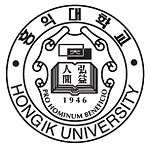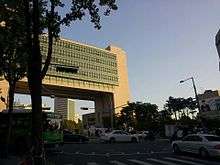Hongik University
Hongik University, widely regarded as the best architecture and art school rivalry with Seoul National University in South Korea, was founded by an independence activist in 1946. It is located in Mapo-gu district of central Seoul, South Korea with a second campus in Sejong.[1] Hongik University has one of the most popular bachelor's degree in architecture & design in South Korea. However the university also offers a comprehensive range of undergraduate and graduate programs. As of 2007, the university was home to 14,500 undergraduate students and 2,600 graduate students, and the undergraduate school consists of College of Fine Arts, College of Education, College of Engineering, College of Liberal Arts, College of Architecture, College of Law, and College of Economics and Business Administration. The graduate school provides research-based and practice-based programs in comprehensive fields including liberal arts, engineering, fine arts and design, education, economics, performing arts, urban planning, architecture, film and photography. The shortened term for Hongik University, "Hongdae," serves as a metonym for the neighborhood.
 | |
| Established | 1946 |
|---|---|
| Founder | Lee Hung soo |
| Location | , |
| Website | Hongik University |
| Korean name | |
| Hangul | |
|---|---|
| Hanja | |
| Revised Romanization | Hongik Daehakgyo |
| McCune–Reischauer | Hong'ik Taehakkyo |



Location
The main campus of the school is in west central Seoul, and the second in Sejong. The neighborhood of the Seoul campus has been renowned for Korean indie music and art culture since the 1980s. Until the 2000s, the district remained as an original indie hipster area for young adults, however, due to the incursion and expansion of corporate brands and real estate development, gentrification has become a serious issue for many years. As an outcome, the neighborhood has also expanded to adjacent areas. It is a very crowded and commercial district full of young adults mostly who would like to enjoy hip restaurants, bars, live and night clubs, and art galleries including alternative art spaces.
History
The university was established shortly after Korean independence. The Daejongkyo founders, upon returning to Korea following Japanese surrender after years of exile in China, prioritized the establishment of an educational institution. As a result, in 1946, they founded the school, then named Hongmoon-daehakgwan (홍문대학관). Lee Hung Soo, a wealthy Korean independent activist, donated the initial funds from which the university found its beginnings. In August 1948, Hongik University and Hongik Foundation was approved officially by the Korean government.
By 1950, the school had expanded steadily to accommodate departments in law, liberal arts, political science, and science. The school was forced to move to Daejeon and Busan during the Korean War. Upon its return to Seoul in 1953, the university continued its growth. In Seoul, the university continued to expand academic programs, including departments of business and economics, education, engineering, fine arts, handicrafts, as well as a Graduate School. The foundation established Hongik Junior Technical College, Hongik Junior and Senior High Schools, Hongik Girls' Junior and Senior High Schools, and Hongik Elementary School. In 1971 Hongik College attained a new status, merging with Soo-Do Engineering College to form Hongik University, with twenty departments in the College of Business and Economics, Engineering, and Fine Arts. It was also in 1971 that the Graduate School of Industrial Arts came into being. Evening classes and the College of Education were added in 1972 and 1973, respectively. In 1981-82, the Ministry of Education authorized the establishment of the College of Liberal Arts, the Graduate School of Environmental Studies, and the Graduate School of Education.
In keeping pace with the growing student enrollment, a program of physical expansion was pursued. The Liberal Arts Building and the Computer Center were completed in 1983 and 1985, respectively, and the construction of the Gymnasium was completed at the end of 1985. Also, two student dormitories were constructed: the first one, a six-story building of 122 square meters, was built in 1988, and the other, a six-story building of 263 square meters with two underground floors, was built in 1989. In the same year, the auditorium, which had been damaged by a fire, was remodeled, resulting in a three-story building of 282 square meters. 1989 also saw the opening of a second campus at Sejong formerly known as Jochiwon, Chungcheongnam-do.
On April 23, 1988, the first phase of construction, including the lecture buildings, gymnasium, auditorium, and dormitories started. Also, sports facilities for baseball, soccer, and tennis were added. All these efforts culminated into 11 buildings as of March 1991. Further expansion took place from 1991 to 1994, with more departments and colleges being added to the university.
The years 1986 through 1988 marked a period of further expansion in Hongik's educational programs. The Graduate School of International Business Administration and the College of Law & Economics were established. The Department of Art Science, the Department of Printmaking, and the Department of Visual Design were added to the College of Fine Arts. In addition, the Institute of Fine Arts & Design Education was set up to provide continuing education for adults.
In keeping pace with the growing student enrollment, a program of physical expansion was pursued. The Liberal Arts Building and the Computer Center were completed in 1983 and 1985, respectively, and the construction of the Gymnasium was completed at the end of 1985. Also, two student dormitories were constructed: the first one, a six-story building of 122 square meters, was built in 1988, and the other, a six-story building of 263 square meters with two underground floors, was built in 1989. In the same year, the auditorium, which had been damaged by a fire, was remodeled, resulting in a three-story building of 282 square meters.
In 1989 the College of Industrial Sciences, with eleven departments, was established at the second campus in Sejong. The preparation for the second campus was initiated by the purchase of a plot of land covering 151,250 square meters in Sejong. On April 23, 1988, the first phase of construction, including the lecture buildings, gymnasium, auditorium, and dormitories started. Also, sports facilities for baseball, soccer, and tennis were added. All these efforts culminated into 11 buildings as of March 1991.
Further expansion took place from 1991 to 1994, with more departments and colleges being added to the University. The Department of Radio Science & Communication Engineering was established in the College of Engineering at the Seoul campus. The College of Industrial Sciences at the second campus was divided into the College of Science and Technology and the College of Visual Arts (now renamed the College of Design and Arts), where the latter included the Department of Industrial Crafts and the Department of Advertisement Design. The College of Business Management was also added during this period.
In 1995 and 1996 Hongik University underwent a major restructuring of the departments of the colleges. Many departments exploring similar fields of study were merged into school systems, thereby allowing students to explore a wider spectrum. Additionally, three more graduate schools were established: the Graduate School of Industry at theSejong campus and the Graduate School of Advertising and Public Relations and the Graduate School of Educational Management at the Seoul campus. Also, in 1995, the university began to expand globally, becoming sister universities with over 32 institutions worldwide, including those in the United States, China, Russia, Japan, the United Kingdom, Spain, Finland, and Australia, among others.
The Hongik International Language Institute was established in 1997 to further support foreign language studies, vital in this age of globalization. The School of Advertising and Public Relations, the first of its kind in Korea, opened in 1998.
The creation of the Gangnam Art Center in 1999 and the establishment of the Daehakro Campus in Hyewha, the most frequented gathering place for youngsters, in 2002, were efforts to establish a system of lifelong education within Hongik University. There were other major happenings in 2002 as well: the Gyeonseong School Foundation was merged with the Hongik Foundation; a new campus was opened in Suwon, which is a city just adjacent to the south of Seoul; in Mallipo, which is on the west coast, the Beach Training Center opened. In 2004, the Graduate School of Film & Design Media and the International Design school for Advanced Studies (IDAS) were established.
The Department of Radio Science & Communication Engineering was established in the College of Engineering at the Seoul campus. The College of Industrial Sciences at the second campus was divided into the College of Science and Technology and the College of Visual Arts (now renamed the College of Design and Arts), where the latter included the Department of Industrial Crafts and the Department of Advertisement Design. The College of Business Management was added during this period.
Notable alumni
- Choi Won-young, actor
- Jo Han-sun, actor
- Kang Eui-sik, actor
- Kim Sung-kyung, actress
- Ko Eun-ah, actress
- Ko Young-hoon, painter
- Kwon Oh-joong, actor
- GRAY, rapper and producer from AOMG
- Maia Ruth Lee, artist
- Loco, rapper from AOMG
- Oh Hyuk, musician from Hyukoh
- Woo Won-jae, rapper from AOMG
- Lee Bul, artist
- Kimsooja, artist
- Ha Chong-hyun, artist
- Park Seo-bo, artist
- Bahc Yiso, artist AKA Bahc mo
- Koo donghee, artist
- Kim Yong-ik, artist
- Kwang-su O, art critique, curator
- Kim Hong-hee, art historian, curator
- Sook-Kyung Lee, curator
- Hong-jun Yu, art historian
- Joo Woo-Jae, actor, model
- Youngwon Kim, engineer
- Chan-Jin Chung, professor & founder of Robofest
Notes
- Goodmorning Media. "World Encyclopedia of Universities". Naver Knowledge Dictionary. NHN Corp. Retrieved 22 October 2012.
References
- (in English) Official history from Hongik University's website
External links
- (in Korean) Official website
- (in English) Official website
- Hongik University at Curlie
- International Design school for Advanced Studies